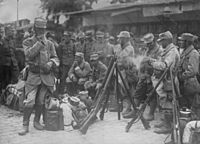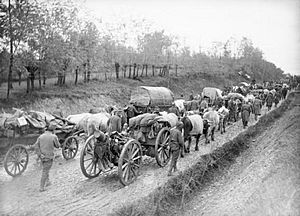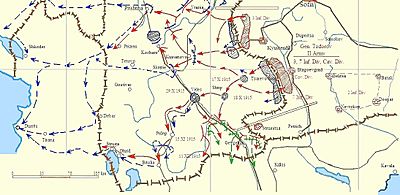Battle of Kosturino facts for kids
Quick facts for kids Battle of Kosturino |
|||||||
|---|---|---|---|---|---|---|---|
| Part of Balkans Theatre of World War I | |||||||
 French soldiers resting in Thessaloniki, 1915 |
|||||||
|
|||||||
| Belligerents | |||||||
| Commanders and leaders | |||||||
|
|||||||
| Units involved | |||||||
|
2nd Army
|
|
||||||
| Strength | |||||||
| 1 army | 2 divisions | ||||||
| Casualties and losses | |||||||
| 400+ killed | |||||||
The Battle of Kosturino was an important fight during World War I. It happened from December 6 to 12, 1915. This battle was part of the early Macedonian campaign, which was a big part of the war in the Balkans. On December 6, Bulgarian soldiers attacked French and British trenches in Kosturino. At that time, Kosturino was part of the Kingdom of Serbia, but today it is in North Macedonia.
Even though the first attack was stopped, Bulgaria managed to get into the Memesli ravine on December 8. They then took control of Crete Simonet, which put the Allied forces in danger of being surrounded. The Allies' defeat at Kosturino meant they had to completely leave Serbia. This allowed the Central Powers to finish building the important Berlin to Constantinople rail line. Meanwhile, the Allies focused on making their defenses stronger in Greece.
Contents
Why the Battle of Kosturino Happened
The killing of Archduke Franz Ferdinand in June 1914 started a chain of events. Austria-Hungary declared war on Serbia. Soon, many major European countries joined the fight. This created two main sides: the Central Powers and the Entente coalition. This was the start of World War I.
After the Ottoman Empire joined the Central Powers in November 1914, Bulgaria's decision became very important. Bulgaria was in a key location next to Serbia. If they joined either side, it would greatly affect the war. Bulgaria and Serbia had fought each other twice recently. Bulgaria lost in 1913 and felt Serbia had taken land that belonged to them.
The Allies could only offer Bulgaria small pieces of land from Serbia and neutral Greece. But the Central Powers offered much more land that Bulgaria wanted. The Allies had also suffered defeats in other battles, showing the Central Powers were strong. So, King Ferdinand of Bulgaria signed a treaty with Germany. On September 21, 1915, Bulgaria began getting ready for war.
Serbia's Difficult Situation in 1915
After the Serbian army won the Battle of Kolubara in December 1914, there was a quiet period on the Serbian front. But in the autumn of 1915, a huge attack against Serbia began. Field Marshal August von Mackensen led the Austro-Hungarian and German armies. They attacked on October 6, 1915.
By September 1915, the Central Powers had taken important cities like Belgrade. They forced Serbian forces to move south. On October 15, 1915, two Bulgarian armies attacked. They quickly defeated Serbian units and took control of areas like Skopje. This stopped the Serbian army from retreating towards the Greek border and Salonika.
The Allies had promised to send help to Serbia, but it took a long time. When Bulgaria started getting ready for war, Serbia's situation became very bad. France and Britain finally sent a small group of two divisions to help. But they arrived too late in the Greek port of Salonika to make a difference. The main reason for the delay was that the Allies needed their soldiers for the Western Front.
The lack of Allied support sealed the fate of the Serbian Army. The Central Powers gathered the Bulgarian, German, and Austro-Hungarian armies under Field Marshal Mackensen. They started their attack on October 7 with a huge artillery bombardment. Then, on October 11, the Bulgarian Army attacked from two directions. They quickly broke through the weaker Serbian forces. With the Bulgarian breakthrough, the Serbian army had no hope. They faced being surrounded or having to retreat.
Marshal Radomir Putnik ordered the Serbian army to retreat south and west. They went through Montenegro and into Albania. The Serbs faced terrible weather, bad roads, and had to help thousands of civilians who were also retreating. Only about 125,000 Serbian soldiers reached the Adriatic coast. From there, Italian ships took them to Corfu and other Greek islands. Later, they went to Thessaloniki. Marshal Putnik was very ill during the retreat and died a year later.
Allied Advance and Retreat
French and British divisions marched north from Thessaloniki in October 1915. They were led by French General Maurice Sarrail and British General Bryan Mahon. On October 20, the French reached Krivolak on the Vardar river. The British took control of the area between the Kosturino Pass, Vardar, and Lake Doiran. This advance helped the retreating Serbian army. It forced the Bulgarians to send more soldiers to their southern side.
The French found out about Bulgarian soldiers in the Babuna Pass. This led to the Battle of Krivolak, which lasted from November 5 to 19, 1915. The French slowed down the Bulgarian advance. This allowed most of the Serbians to escape. However, Bulgaria kept control of Mount Arkhangel, forcing Sarrail to start retreating towards Thessaloniki.
Meanwhile, the British forces had only met small groups of Bulgarian soldiers who had left their army. These soldiers told them that the Second Bulgarian Army had been strengthened at Strumica. On November 26, 1915, bad weather made the steep land impossible to cross. The rain and snow continued until December 3, soaking the soldiers and ruining their coats. Many soldiers had to be sent back to Salonika because of frostbite and exhaustion. This weakened the 10th Irish Division.
On the same day, the French forces began to leave. This left the left side of the 10th Irish Division dangerously exposed. Bulgaria now had 120 groups of soldiers ready to attack the Allies' 50 groups. On the morning of December 4, the Bulgarians built bridges across the Crna river. They quickly took control of Bitola.
The Battle of Kosturino Begins
On December 4, 1915, Bulgaria started firing artillery at British positions along the Kosturino ridge. This artillery attack continued until December 6, when it became even stronger. The bombing was heaviest at 2:30 p.m., focusing on Rocky Peak. This area was held by the Connaught Rangers.
Half an hour later, small groups of Bulgarian soldiers tried to move down the ridge. They were stopped about 60 yards from the British trenches. The Bulgarians briefly took Rocky Peak. But the Royal Irish Fusiliers fought them back in hand-to-hand combat. As night fell, Rocky Peak was made stronger with more soldiers and a machine gun.
Before dawn on December 7, the Bulgarians used heavy fog to sneak up to Rocky Peak. They attacked with bayonets. The defenders struggled to tell friends from enemies and had to fight their way back down the slope. A machine gun was quickly brought to the peak. It fired at the 30th British Brigade with help from mountain artillery.
Between 9 and 10 a.m., the Connaught Rangers stopped a Bulgarian infantry attack. A similar attack on the French part of the front was also held back. At 2 p.m., four Hampshire companies had to fall back to Crete Simonet. They were under heavy fire from the side. A later attack on the Connaught Rangers forced them out of their trenches. They regrouped in Dedeli with the Hampshires.
To the left, the Royal Munster Fusiliers held their ground. But when they heard about the Connaught Rangers' retreat, they also moved back to Dedeli. The 31st British Brigade left Prsten for higher ground in Tatarli. General Mahon asked for help, and the 65th British Brigade was sent to Dojran. French General Maurice Bailloud also sent a mountain battery and two groups of soldiers to Tatarli. At the same time, the French rear guard fought small battles as they retreated towards Furka.
Bulgarian Breakthrough and Allied Retreat
On the morning of December 8, French mountain artillery stopped a Bulgarian attack. This attack was aimed at the point where the 156th French Division met the British positions. At 11 a.m., Bulgaria started its attack again on Crete Rivet. Two attacks were fought off. However, the three companies holding the position had to leave after losing 64 men.
At 3:30 p.m., the British command received a report. It said that Bulgarian soldiers had gotten into the Memesli ravine. They were trying to attack the right side of the 31st British Brigade. They were also getting through between the 5th and 6th Royal Inniskilling Fusiliers in the center. The 31st and 30th British Brigades were ordered to fall back immediately.
At 5:45 p.m., the Bulgarian army took over Crete Simonet. They captured ten artillery guns. They celebrated by blowing bugles and launching flares. At 2 a.m. on December 9, the 156th French Division moved to Bajimia. They had fought off a Bulgarian attack that left 400 Bulgarians dead. No fighting happened for the rest of the day. On December 10, small fights continued as Bulgarian groups bothered the retreating Allies.
At 1 p.m. on December 11, the 11th Bulgarian division took Bogdanci. They cut the local telephone line and captured a place where ammunition was stored. The Allies had chosen the Doiran train station as their new goal. They were getting ready for a complete evacuation towards Salonika. However, the 9th King's Own Royal Regiment was separated from the other Allies. They only started their retreat at 12:45 a.m. on December 12.
An hour later, the regiment met a group of soldiers resting by the road. They realized too late that these were enemy soldiers. The resulting bayonet charge led to 122 British soldiers being killed or captured. By the evening of the same day, the Allied troops had completely left for Greece. The 10th British and the 57th, 122nd, and 156th French Divisions crossed the border. Greek border guards told the Allies they would stop any Bulgarian attempt to cross. A spy later confirmed that Bulgaria did not plan to cross the border. They stopped 2 km from it instead.
The battle at Kosturino and the Allies' retreat resulted in 1,209 British casualties. This included 99 killed, 386 wounded, 724 missing, and ten artillery pieces lost. French casualties were 1,804 killed, wounded, or missing. They also lost 12 machine guns and 36 ammunition wagons. The number of Bulgarian losses is thought to be much higher than the Allies', with at least 400 killed on December 9 alone.
What Happened After the Battle
The Central Powers won a clear, though not complete, victory. This allowed them to open the railway line from Berlin to Constantinople. This meant Germany could send supplies to its weaker partner, the Ottoman Empire.
Despite the Central Powers' victory, the Allies managed to save part of the Serbian army. Even though they were tired, smaller, and almost without weapons, they avoided being completely destroyed. After getting reorganized, they were able to fight again six months later.
Most importantly for the Central Powers, the Allies used the reason of saving the Serbian army to create a new front in Macedonia. This was done by entering a country that was officially neutral. This new front would be very important for their final victory three years later. The Allies focused on making their defenses stronger in preparation for a large Bulgarian attack on Greece and Salonika.
Gallipoli Campaign Ends
After the August Offensive failed, the Gallipoli Campaign began to slow down. The Ottoman Empire's success started to affect public opinion in the United Kingdom. News about General Ian Standish Monteith Hamilton's poor performance was shared by journalists. Other unhappy officers also added to the overall feeling of gloom.
The idea of leaving Gallipoli was brought up on October 11, 1915. But Hamilton did not want to, fearing it would hurt British pride. He was soon removed as commander and replaced by Lieutenant General Sir Charles Monro. Autumn and winter brought relief from the heat. But they also brought strong winds, blizzards, and floods. This caused soldiers to drown and freeze to death, and thousands suffered frostbite.
After talking with other commanders, Sir Herbert Kitchener agreed with Monro. He passed his recommendation to the British government, who decided to evacuate in early December. The last troops left before dawn on December 20, 1915. The number of troops had been slowly reduced since December 7, 1915. Tricks were used to hide the Allied departure, like a rifle that fired by itself. At Anzac Cove, troops stayed silent for about an hour. Curious Ottoman troops came to check the trenches, and the Anzacs opened fire. The last British troops left around 4:00 a.m. on January 8, 1916. The Newfoundland Regiment was part of the group that stayed behind. They finally left Gallipoli on January 9, 1916.
See also
Images for kids
Sources
- Falls, C. (1996). Military Operations Macedonia: From the Outbreak of War to the Spring of 1917. History of the Great War Based on Official Documents by Direction of the Historical Section of the Committee of Imperial Defence. I (Imperial War Museum and Battery Press ed.). London: HMSO. ISBN 978-0-89839-242-5.




